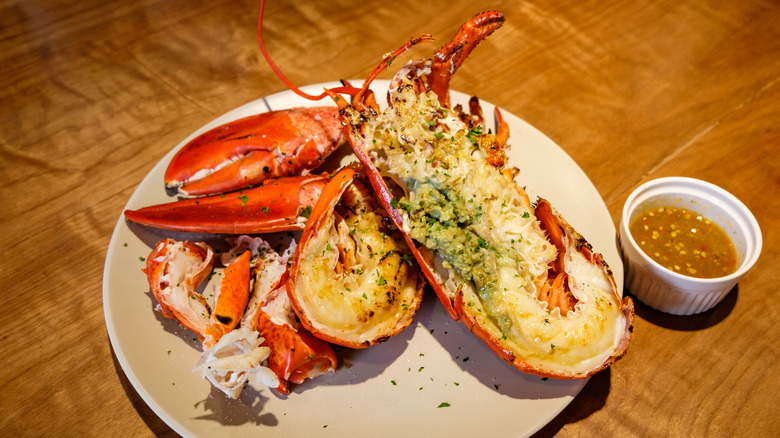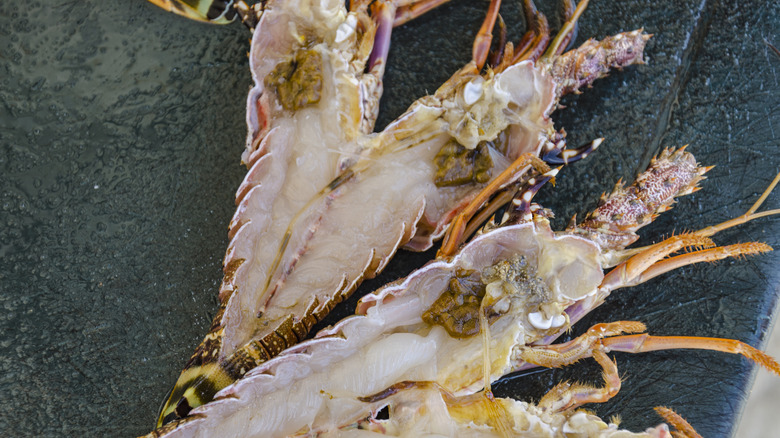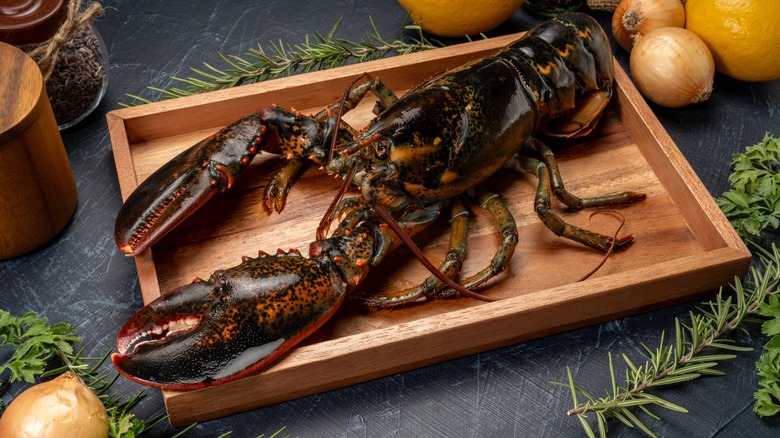What's The Green Stuff In My Lobster And Can I Eat It?
Summer in the northeast states means lobster, and lots of it. Whether you go big with a decadent lobster thermidor or keep it simple with a lobster roll picnic, the celebrated crustacean is always a hit. Most people go straight for the tail or claws, which are the most popular parts of the lobster due to their meaty nature, but many of the most die-hard lobster lovers have something else in mind. They go for the lobster's body cavity, cracking it open to reveal what looks like a bright green paste coating the tender white meat.
This paste is known as tomalley, and it is renowned for its rich taste, providing an ultra-concentrated hit of lobster flavor, along with its smooth, buttery texture. However, it is a controversial food as well. The tomalley is actually one of the lobster's internal organs, and the role it plays in the crustacean's digestive system has health officials concerned about a number of potentially toxic contaminants.
What is tomalley?
Lobster tomalley is actually an organ called the hepatopancreas. It is also found in other crustaceans, most notably crabs, in which it is sometimes called "mustard". The hepatopancreas essentially functions as a combined liver and pancreas. It filters toxins out of the lobster's blood, which, as you'll see, has raised concerns about eating it. Some people also find that tomalley has a faint metallic taste akin to the organ meat of other animals. Nevertheless, the green paste is widely considered a delicacy in New England and beyond.
From a culinary standpoint, tomalley is quite versatile. Some people mix it into lobster bisque while others spread it on crostini like pâté. Some even mix it with butter or use it in an aioli. However, one of the most common ways to eat lobster tomalley is to simply scoop it up with a spoon and enjoy it alongside the meat.
Tomalley is found in both male and female lobsters, but there are differences between the two. Tomalley from male lobsters is typically a brighter green color while the tomalley from female lobsters has more of a yellow hue. Female lobsters' tomalley also has a smoother texture than that of the males, which some people prefer.
Is tomalley safe to eat?
Discarding the tomalley might sound like another wasteful lobster mistake, and ardent fans of the creamy paste would balk at the thought of missing out on it. However, health officials have consistently warned diners not to eat tomalley. If the lobster consumes any pollutants, they can build up in the hepatopancreas. The rest of a lobster can also contain some toxins, but they are released into the water when the lobster boils. The toxins in the hepatopancreas are not water-soluble, meaning they are still in there when you eat it.
The hepatopancreas can contain toxic chemicals, like mercury and PCBs, that are released into the oceans via human pollution. It can also absorb toxins that are naturally present in the ocean. The FDA has issued warnings in the past, cautioning diners not to eat tomalley for this reason. Eating it is especially dangerous if there was a red tide in the lobster's environment. A red tide, also known as a harmful algal bloom, or HAB, happens when large amounts of toxic algae accumulate in a certain area. Lobsters and other crustaceans eat the algae, filtering their harmful elements through the hepatopancreas.
Ingesting the toxins found in tomalley can cause paralytic shellfish poisoning, a condition that can cause a person to act inebriated, and in extreme cases, can cause fatal respiratory issues. In light of this, it is recommended to consume tomalley in extreme moderation, if at all.


